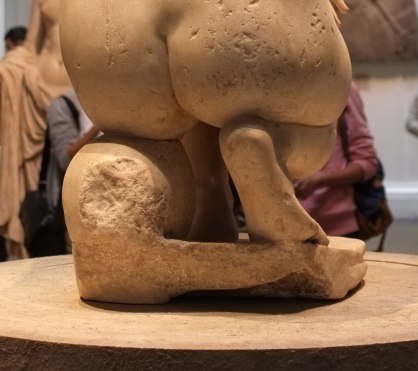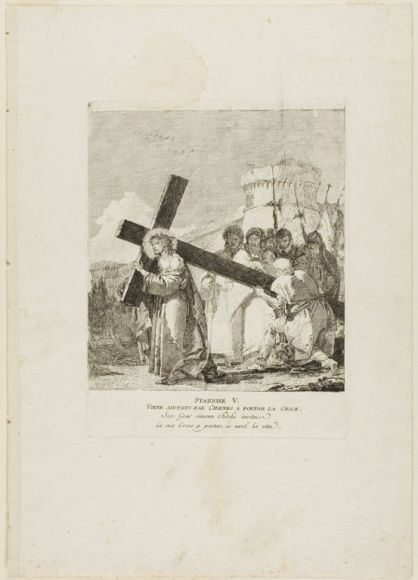I saw Edgar Degas’ “The Tub” and Jeff Koons’ “Woman in a Tub”at the Art Institute of Chicago back in April and was inspired to write about paintings and sculptures depicting a woman having a bath.
The following post is relevant to the Art Institute of Chicago
This is a personal view (most views are). I selected the paintings and sculptures I like and/or find interesting.
One of the most important feature of the paintings and sculptures is – of course – the way the artist has depicted the female body.
Another is the degree of privacy and intimacy of the instance depicted.

I would like to start the journey with Ingres. The painting “The Bather of Valpincon” (my thanks for the photo to “The Art Appreciation Blog“) that hangs today in the Louvre in Paris marks in my book the beginning of a new era in the depiction of the nude female. The setting is domestic, the subject is alone. And the body is not perfect. The depicted woman is a real woman. There is no story in the picture. It is a “boring” mundane scene in the domestic life of a woman.
Although there is not tub in Ingres’ picture, in my view he creates the context for the topic of my overview.

Woman in a tub
1878 Paris, Musée d’Orsay
Pastel on canvas
The first painting strictly within the context of this article is Manet’s “Woman in a Tub”. Manet painted his picture in 1873.
My adoration of Manet started with “Olympia” (1863) and “The Luncheon on the Grass” (1862-1863), both exhibited in Paris’ Musee d’ Orsay.
I quote from Musee d’ Orsay’s web site:
“This pastel is one of the artist’s most beautiful portrayals of a woman bathing. All the characteristics of Manet’s style are there: a special blend of spontaneity, freshness combined with precise composition, and a taste for light, curving lines against a background of horizontals. The background is in fact divided up into subtly coloured bands, formed by the mirror, the dressing table and the floral cretonne cloth.
A large metal tub, always used by Degas in these scenes, occupies the lower part of the pastel. But whereas Degas’ models usually appear to be unaware of the viewer, here the model is unconcerned at being observed by the painter. She knows that her nudity, even though imperfect, will attract a friendly or even tender glance.
After Manet’s death, Degas produced his stunning series of women bathing, where he used plunging perspectives and more sophisticated poses. But it was Degas who, after 1877, first started to produce less innocent scenes of women washing, painted in brothels. It is difficult to determine from that point, which of the two artists had the greater influence on the other. Degas’ sarcasm is absent from Manet’s work; it is Bonnard’s gentle scenes of women at their toilette that are the real precursors of this Woman in a Tub.”
The palette of the picture is light. Only the tub turns to heavy grey.

La blonde aux seins nus
vers 1878
huile sur toile,
musée d’Orsay, Paris, France
Contrast the bathing woman to the bare breasted blonde of the same year. The air of “neutral” intimacy of the bathing woman is gone, and replaced by the naked aggression of the breasts. Totally different.

I continue with another master, Edgar Degas.
Degas’ picture “Woman standing in her bathtub”, painted in 1883, adorns the exhibition halls of Tate Gallery in London.
It was in London’s National Gallery in 1996 that I saw the exhibition “Degas beyond impressionism”. This exhibition marked the beginning of my admiration for Degas’ work.
The woman seems to be drying herself, and is totally absorbed in what she is doing.
The picture is full of contrasting lights and shadows, of bright and dark colors.

Edgar Degas
Charcoal and pastel on paper, Metropolitan Museum, New York
Another nude in a tub by Degas is the picture he painted in 1885, which you can see today in the Metropolitan Museum of Art, New York.
When Degas exhibited his “suite of nudes,” which included this pastel, at the eighth—and final—Impressionist exhibition, in 1886, critics viciously attacked the ungainly poses of his bathers. After the exhibition, Degas gave the picture to Mary Cassatt in exchange for her Girl Arranging Her Hair (National Gallery of Art, Washington, D.C.).

The Tub, modeled 1889 (cast 1919/21)
And now the tub I saw at the Art Institute of Chicago.
I quote the Art Institute of Chicago’s text:
“This charming work, cast in bronze after Degas’s death, is a particularly appealing, even playful, variation on that subject. In a round basin partially filled with water, a young woman relaxes and absently plays with the toes of her left foot…The Tub is innovative in another, more subtle way. The female nude is of course a central subject in the history of Western art, associated with many conventions and traditions. However, unlike so many of his predecessors and more conservative contemporaries, Degas did not depict his adolescent bather in the guise of a nymph or goddess, nor did he imbue her features and gestures with eroticism. Instead, she is self-absorbed, modest, and engaged in a mundane activity.”

The Bath – Baignoire (Le Bain) 1925
Oil paint on canvas, Tate Gallery, London
“Like Degas, Bonnard painted a lot of nudes in the bath. Sometimes he even photographed them. So the bathtub appears as a kind of original place, Plato’s chora in which forms materialize, or space, the matrix of Derrida.”
“This is one of a series of paintings that Bonnard made of his wife Marthe in the bath. Though she was in her mid-fifties, the artist depicts her as a young woman. Marthe spent many hours in the bathroom: she may have had tuberculosis, for which water therapy was a popular treatment, or she may have had an obsessive neurosis. The bath, cut off at both ends, and the structure of the wall create a rigorously geometric composition. The effect is strangely lifeless, and almost tomb-like; as if the painting were a silent expression of sorrow for Marthe’s plight.”
Matisse, Large reclining nude (The Pink Nude)

La Grande Baignoire (Nu), 1937–1939
The Large Bathtub (Nude)
Oil on canvas, 94 × 144 cm
Private collection
Pierre Bonnard: La Grande Baignoire (Nu), 1937–1939
The Large Bathtub (Nude)
There is a formula, which fits painting perfectly,” wrote Bonnard, “many little lies to create a great truth.”

Oil on canvas. 48 x 59 1/2″ (121.9 x 151.1 cm). Carnegie Museum of Art, Pittsburgh
Bonnard 1941-1946: Nude in the Bath and Small Dog (with thanks to Sheila Thornton)
The efflorescent explosion of colors in “Nude in the Bath and Small Dog” (1941-46) almost bars us from making any sense of the painting were it not for a few key recognizable objects–notably the dog and the bathtub, within which the details of the immersed figure of Marthe slowly appears. Bonnard places the figure frankly in the center of this fantastic scene. We witness the inanimate becoming animate as the bathtub mutates to adhere to Marthe’s form: bulging to accommodate the bend of her right knee and expanding with the curve of her head. The walls seem to gently breathe like a living organism, warping in dazzling, undulating waves along with the ripples of the tub water.
Ostensibly the scene is serenity itself, yet Bonnard allows us no rest in front of it. Not only does the bathroom sway in our vision, the whole of it will not come into focus at once from any one position. We must move from side to side and back and forth. By thus “performing” the painting we are made all the more conscious of our movement in contrast to the stillness of Marthe’s body. Marthe died in 1942, at age 72, before Bonnard had finished the painting.
Nude in Bathtub, the last of Bonnard’s treatments of this subject, is one of the great nudes of the twentieth century. The audacity of color that characterizes the artist’s mature work is evident in this painting’s dazzling mosaic of oranges, yellows, pinks, blues, violets, and greens. The originality of Bonnard’s chromatic daring is nearly equaled in this painting by a pictorial construct in which perspective and volume are denied and forms are piled up to hover over the flat plane of the canvas.
Bonnard transformed this domestic environment, with its comfortably curled-up family dachshund, into an exotic setting in which a young woman floats in a pearly tub, her flesh reflecting the opalescent colors that surround her. Marthe appears as the youthful woman of Bonnard’s memories. The result is a sensual, dreamlike, and private evocation.

Landing from Bonnard to Koons is a shock.
It is like landing on another planet.
In the website of the Art Institute of Chicago, we read:
“Woman in Tub, based on a postcard, depicts a female nude acting out a crude sexual joke in the bathtub. Jeff Koons explained: “There’s a snorkel and somebody is doing something to her under the water because she’s grabbing her breasts for protection. But the viewer also wants to victimize her.” The cartoonlike rendering of the form belies the exquisite hard-paste porcelain finish, typical of 18th-century Rococo figurines. Part of his Banality series, which is characterized by oddly eroticized, comic, and kitsch images, this work demonstrates Duchampian and Pop Art strategies of appropriation and, combining imagery from multiple sources, makes the primary subject taste itself.” (1)

An article in Art Tattler International informs us: Koons has a strong connection to Chicago where he came in the 1970s to study at the School of the Art Institute under artists Ed Paschke and Jim Nutt and briefly worked at the MCA as a preparator. For Koons, this was a critical time in his development — what he calls a period of transcendence. In practical terms, working for and befriending the artist Ed Paschke taught him that he could be a professional artist. Koons began to see his ideas in dialogue with Dada, Surrealism, and the Chicago Imagists, all genres that communicate with personal icons: from Salvador Dali’s mustache to Paschke’s tattoo parlors. Through Paschke and others, he looked to the external world to find his personal iconography, which he used to explore his subjectivity, transcend his limits, and fulfill his potential as an artist.
It is time to recap.
What a journey!

Manet’s picture is effecting a dialogue between the woman/model and the observer/painter.
There is no idealization of the female body.

Degas is painting with passion, but the woman looks like an object enclosed in a solitary space.
We can see her, but she cannot. She is alone.
No idealization of the female body here.

Bonnard moves us to a different world.
The interplay between the flesh and th water, the function of the tub as the defining space, the luminosity of the tiles, they all contribute to create a world of ever changing illusion.

Koons is ending the journey as a hurricane, There is violence, panic, and sensuality. And a very peculiar sense of humour.
Relevant posts:
Painting the human body, October 2011
Three female nudes, October 2010
















































































































































